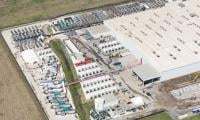History and features of Lahore’s Sundar Industrial Estate
LAHORE: Located 45 kilometres from the centre of Lahore on the Sundar-Raiwind Road, the Sundar Industrial Estate was inaugurated in February 2007 by the then Pakistani President General Pervez Musharraf, writes Sabir Shah.During the inauguration ceremony, General Musharraf was escorted by the then Governor Punjab General Khalid Maqbool, Chief
By our correspondents
November 05, 2015
LAHORE: Located 45 kilometres from the centre of Lahore on the Sundar-Raiwind Road, the Sundar Industrial Estate was inaugurated in February 2007 by the then Pakistani President General Pervez Musharraf, writes Sabir Shah.
During the inauguration ceremony, General Musharraf was escorted by the then Governor Punjab General Khalid Maqbool, Chief Minister Pervaiz Elahi and the then Federal Minister for Industries, Jahangir Khan Tareen.
Having 702 industrial land plots spread over an area measuring 1,179 acres, the Sundar Industrial Estate actually comprises of 1,750 acres of land.
These 702 industrial plots include: 396 one-acre plots, 112 half acre plots, 101 two-acre plots, 37 three-acre plots, 14 four-acre plots, 34 five-acre plots and 22 plots measuring over five acres.
Managed by the Punjab Industrial Estates Development and Management Company, the Sundar Industrial Estate had reportedly attracted an investment to the tune of Rs40 billion between 2009 and December 2014. By December 2014, as many as 350 industrial units were operational at Sundar, while another 210 factories were under construction.
This was the time when the management led by renowned industrial tycoon S.M. Tanveer was hoping that another 150 new units in the pipeline would start functioning too.
According to an October 2012 survey report, there were 11,000 factories functioning in residential areas across the province of Punjab. The survey was carried out on the directives of Dr. Shujaat Ali, the then Secretary of Punjab Industries, Commerce and Investment Department.
The shocking survey report had revealed that 7,750 of these factories were in Lahore, 1,463 in Gujranwala, 338 in Faisalabad, 283 in Multan, 87 in Kasur and 86 were operational in Sialkot.
Some 4,500 of the 7,750 factories in Lahore were classified as cottage industries and not fewer than 817 units were found using boilers in Punjab’s residential areas.
Boilers are normally installed in units involved in the business of shoemaking, rice processing, rubber, food, paper and manufacturing of pharmaceuticals etc.
Of these 817 units equipped with boilers, around 325 factories were found using substandard boilers.
These 325 factories included 77 functional in Lahore, 98 in Gujranwala, 121 in Faisalabad, 25 in Multan and three in Rawalpindi.The then DCO Lahore, Noorul Amin Mengal, had given a seven-day deadline to the owners of all the industrial units in the city to complete the installation of fire safety equipment.
These orders were passed less than a month after a shoemaking factory located at Band Road in Gulshan-i-Ravi locality of Lahore had caught fire on September 11, 2012 (the same day as Karachi’s Baldia Town factory was gutted), leading to deaths of 25 people by smoke inhalation, burns and stampede.
The Lahore factory had caught fire when sparks from a faulty electricity generator had flown into a pile of chemicals stored within the unit’s vicinity. Since the unit’s electricity generator was installed in the garage of the factory compound, which was also the only entry and exit point of the factory, people working inside could not find an immediate way out and were trapped in the inferno.
(Reference: A September 11, 2012 report of the BBC News)
During the inauguration ceremony, General Musharraf was escorted by the then Governor Punjab General Khalid Maqbool, Chief Minister Pervaiz Elahi and the then Federal Minister for Industries, Jahangir Khan Tareen.
Having 702 industrial land plots spread over an area measuring 1,179 acres, the Sundar Industrial Estate actually comprises of 1,750 acres of land.
These 702 industrial plots include: 396 one-acre plots, 112 half acre plots, 101 two-acre plots, 37 three-acre plots, 14 four-acre plots, 34 five-acre plots and 22 plots measuring over five acres.
Managed by the Punjab Industrial Estates Development and Management Company, the Sundar Industrial Estate had reportedly attracted an investment to the tune of Rs40 billion between 2009 and December 2014. By December 2014, as many as 350 industrial units were operational at Sundar, while another 210 factories were under construction.
This was the time when the management led by renowned industrial tycoon S.M. Tanveer was hoping that another 150 new units in the pipeline would start functioning too.
According to an October 2012 survey report, there were 11,000 factories functioning in residential areas across the province of Punjab. The survey was carried out on the directives of Dr. Shujaat Ali, the then Secretary of Punjab Industries, Commerce and Investment Department.
The shocking survey report had revealed that 7,750 of these factories were in Lahore, 1,463 in Gujranwala, 338 in Faisalabad, 283 in Multan, 87 in Kasur and 86 were operational in Sialkot.
Some 4,500 of the 7,750 factories in Lahore were classified as cottage industries and not fewer than 817 units were found using boilers in Punjab’s residential areas.
Boilers are normally installed in units involved in the business of shoemaking, rice processing, rubber, food, paper and manufacturing of pharmaceuticals etc.
Of these 817 units equipped with boilers, around 325 factories were found using substandard boilers.
These 325 factories included 77 functional in Lahore, 98 in Gujranwala, 121 in Faisalabad, 25 in Multan and three in Rawalpindi.The then DCO Lahore, Noorul Amin Mengal, had given a seven-day deadline to the owners of all the industrial units in the city to complete the installation of fire safety equipment.
These orders were passed less than a month after a shoemaking factory located at Band Road in Gulshan-i-Ravi locality of Lahore had caught fire on September 11, 2012 (the same day as Karachi’s Baldia Town factory was gutted), leading to deaths of 25 people by smoke inhalation, burns and stampede.
The Lahore factory had caught fire when sparks from a faulty electricity generator had flown into a pile of chemicals stored within the unit’s vicinity. Since the unit’s electricity generator was installed in the garage of the factory compound, which was also the only entry and exit point of the factory, people working inside could not find an immediate way out and were trapped in the inferno.
(Reference: A September 11, 2012 report of the BBC News)
-
 Duke's Peace Talks With King Charles, Prince William: 'Ball Is In Harry's Court'
Duke's Peace Talks With King Charles, Prince William: 'Ball Is In Harry's Court' -
 New Research Finds Back Pain May Disrupt Men’s Sleep Quality Later In Life
New Research Finds Back Pain May Disrupt Men’s Sleep Quality Later In Life -
 Jennifer Lopez Still 'very Close' With Ben Affleck's Children, Invites Them To Vegas
Jennifer Lopez Still 'very Close' With Ben Affleck's Children, Invites Them To Vegas -
 Matt Damon Gets Honest About Netflix's Way Of Storytelling
Matt Damon Gets Honest About Netflix's Way Of Storytelling -
 Prince William, Harry Rift Still 'simmering Away'
Prince William, Harry Rift Still 'simmering Away' -
 What's Buzzing Around TikTok's 'PineDrama' App: Everything You Need To Know
What's Buzzing Around TikTok's 'PineDrama' App: Everything You Need To Know -
 Who’s Next After Australia’s Under-16s Social Media Ban?
Who’s Next After Australia’s Under-16s Social Media Ban? -
 Do You Have Depression Or Is It Just Monday Blues? Find Out Where Science Stands
Do You Have Depression Or Is It Just Monday Blues? Find Out Where Science Stands -
 Why Claude Is Gaining Momentum In Revolutionizing The AI Landscape
Why Claude Is Gaining Momentum In Revolutionizing The AI Landscape -
 Elon Musk Unveils Plans To Take Humanity To The Moon And Mars
Elon Musk Unveils Plans To Take Humanity To The Moon And Mars -
 Air Pollution May Play A Role In Prostate Cancer Risk, Experts Warn
Air Pollution May Play A Role In Prostate Cancer Risk, Experts Warn -
 Royal Expert Reveals Real Reason King Charles Won't Meet Prince Harry Next Week
Royal Expert Reveals Real Reason King Charles Won't Meet Prince Harry Next Week -
 Ansel Elgort Welcomes His First Baby In Secret
Ansel Elgort Welcomes His First Baby In Secret -
 Startup Aims To Brighten Night Skies With Space Mirrors
Startup Aims To Brighten Night Skies With Space Mirrors -
 Cheaper Cars, Fewer EVs: Trump Administration Shifts ‘auto Policy’ Focus
Cheaper Cars, Fewer EVs: Trump Administration Shifts ‘auto Policy’ Focus -
 Meghan Markle Takes 'breadwinner' Role In Prince Harry's California Life
Meghan Markle Takes 'breadwinner' Role In Prince Harry's California Life



